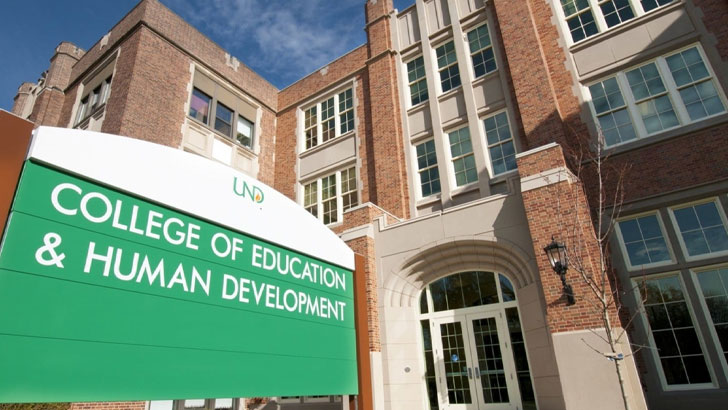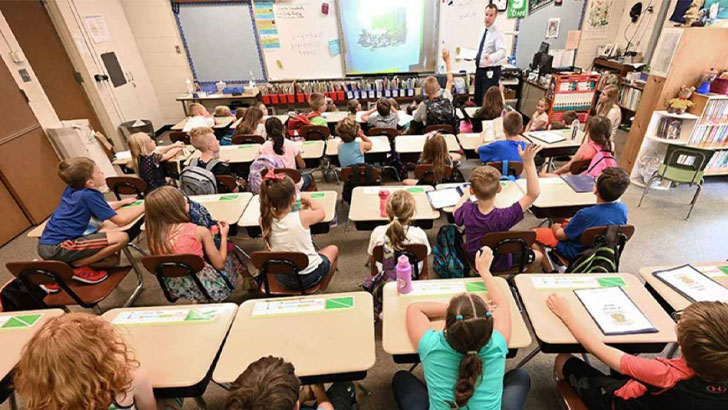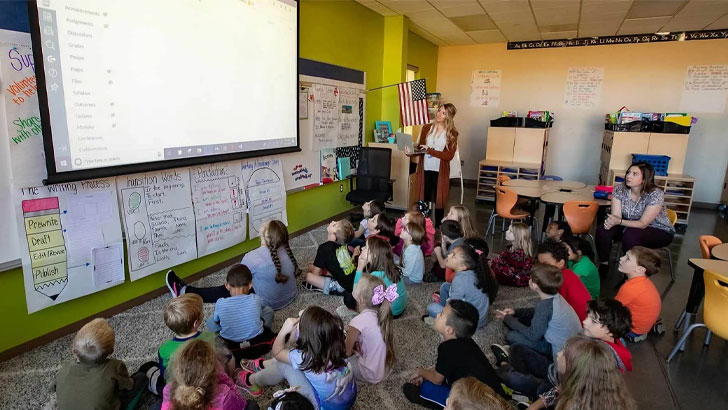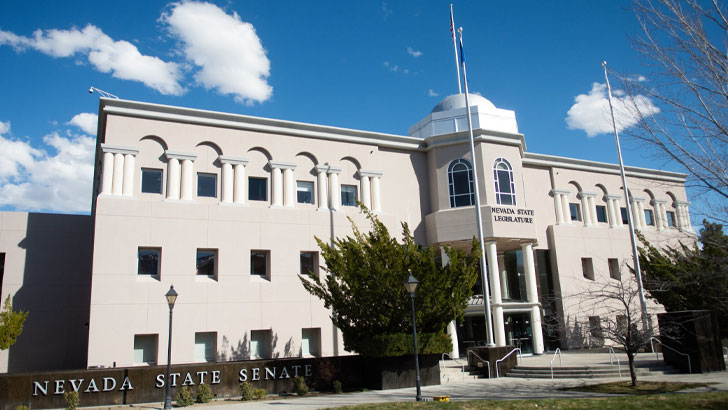TRENDING
Ranking States From Most To Least Educated
Published
3 years agoon
A state’s education system is a critical factor in determining where to raise a family, because as we know, quality structure and development is important to all parents. If you don’t have access to quality learning environments, kids may struggle to stay engaged, or dismiss potential career opportunities altogether. Some states are getting it very right, while others are on the wrong path…

Just because a state’s education system is struggling now doesn’t mean it’s doomed forever though, and many states have made great strides in improving the overall effectiveness and quality of teachers, facilities and even external resources that are available to students. Here we will count down the states ranking them from most to least educated, judged by a cohesive score.
Massachusetts

Overall Score: 81.82
Massachusetts’ education system has been the all-around best in the country for a while now, and it’s largely due its high rate of passing reading and math scores. But its taxpayers are a huge help, as a greater percentage of funding comes from the people of the commonwealth. This has led to quality education throughout the state, which has allowed them to lead the pack going into higher education (where they also pass with flying colors).
Maryland

Overall Score: 78.48
Maryland isn’t far behind Massachusetts in their education successes, and a main cornerstone for why is the Maryland Blueprint, which was a comprehensive piece of legislation that focused heavily on early childhood education, and its retention into the early public school system. And not only do they have resounding success when it comes to test scores, but they’ve also incentivized their reach in technical education programs and career planning.
Connecticut

Overall Score: 72.68
With a graduation rate of over 88%, it’s no surprise that Connecticut is one of the best public school systems in the country. Now you may attribute that to their low population, but seeing nearly 9 in 10 kids excel in test-taking is certainly something other states would like to duplicate. They also made legislative changes that focus on the retention of educators, while prioritizing knowledgeable and respected teachers to the point where they even recruit out of state.
Colorado

Overall Score: 69.82
Colorado has become one of the most popular states in the country, and with many moving there and raising families, education has become increasingly important. But they’ve stood up to the challenge, because not only are students getting early starts, but they have one of the best high school graduation rates, and some of the highest bachelor and graduate degree holders of all states. That’s pretty good for a state that is over 50% rural as far as population is concerned.
Vermont

Overall Score: 69.67
Education quality is one of the biggest draws for anyone living in Vermont, mostly because of how easy it is to find quality educators and institutions, but also because of its comprehensive curriculum. 94% of teachers retain their jobs year over year, and from early childhood education to college and technical schooling, Vermont has invested highly in preparing students for the future.
New Jersey

Overall Score: 69.19
New Jersey may be small, but with such a dense and diverse population, they’ve taken it to heart to provide all students and families –regardless of class or cultural background – with quality schooling. In the over 2,300 schools across their 546 school districts, Jersey ranks 6th overall in the nation across the board, whether we’re talking about access to special education, technical training, and secondary education that exports students out of state at one of the highest rates.
Virginia

Overall Score: 68.83
Home of Washington D.C. (kind of), it’s no surprise that the standard that needs to be met in the state of Virginia regarding education is important. Not only is the foundational history of the country rooted in this region, but they also have access to some of the best history and learning institutions in the country. Their Standards of Learning program also is a key factor in monitoring individual students’ progress to ensure they’re getting the attention they deserve.
New Hampshire

Overall Score: 68.65
In keeping with the theme here, it’s evident that smaller states have a better grip on their younger population than those with many more residents. This could be due to distribution of tax dollars, but New Hampshire has made it a point to go above and beyond to provide advanced primary education curriculums that span more subject points than nearly anywhere else. Their secondary education quality also ranks towards the top, despite having a lower rate than some of their surrounding neighbors.
Minnesota

Overall Score: 64.53
A key factor in Minnesota’s education system seeing success is the low student-to-teacher ratio, meaning students have more opportunities to work individually with their instructors, which is proven to improve confidence and test scores. They also have one of the lowest dropout rates in the country, which has allowed them to have a top-3 ranking when it comes to high school graduation rates for the past couple decades. For a bigger state, Minnesota is setting the bar high.
Washington

Overall Score: 63.30
Washington state has some of the highest performing school districts in the country, and that is largely thanks to the high population densities in certain areas. Having to focus on a large number of students under one umbrella can be good and bad, whereas they know where the funding needs to go, but it being hard to track that monetary application to the individual student. Washington isn’t unique in struggling in rural areas, but distributing education funding evenly, especially for the east part of the state, will be a focus in the future.
Utah

Overall Score: 63.23
While it’s fairly common knowledge that Utah has a much higher percentage of private schools in comparison to other states, they’re still ranked under the same classifications of education attainment and quality. And while they do have easier access to local schools fitting the needs of their respective populations, they do struggle with student-to-teacher ratios, meaning children get less focused attention in the sense that the state itself is not investing as much as it should on the individual. In the future, they may move more funds over from the institution.
Illinois

Overall Score: 58.25
Since Illinois has a city like Chicago, it’s almost unfair to the rest of the state to be grouped into such a complex city’s education system. Of course, the more outside the metro you go, the smaller the classrooms and the more suburban the conditions and curriculum may be. However, despite popular misconceptions, Chicago and all of Illinois are doing a great job in funding both the inner-city and suburban communities, and that’s evident by their secondary school enrollment.
New York

Overall Score: 57.37
New York might immediately strike you as a difficult place to find quality education, but the state has actually done a wonderful job at providing quality and opportunities at thousands of schools throughout not only the city, but all through the rest of western New York. Because the desirability to live in the state is so high, there’s many quality educators and often time the local governments invest heavily in the youth populations with a hyper focus on education.
Oregon

Overall Score: 57.23
For Oregon, a big part of their education successes have come from the grassroots level, and the hard work and dedication of teachers and other instructors has brought students a long way. But Oregon struggles to attain funding through taxes, and that’s resulted in lower test scores and more students earning diplomas. But the future’s looking brighter for Oregon students, as more concentrated efforts are reaching to all corners of the state with revised budgeting and higher teacher salaries.
Rhode Island

Overall Score: 56.62
Rhode Island recently moved away from the Common Core State Standards to one of their own, and it’s going to determine the quality of education in the state going forward. Oftentimes states assuming complete responsibility for their own education curriculum can be problematic, but a bi-partisan approach on thoughtful and inclusive course objectives is common in the state of Rhode Island, so people may be more likely to have a say in their community, ranking them higher on this list.
Delaware

Overall Score: 55.94
Another small northeastern state like Delaware also climbs higher than expected on this list because of the state’s lower square footage and population, meaning that once again, personal interaction between teachers and students is proven to be more beneficial thanks to the additional attention that each child receives. They also offer school choice, which ensures parents they’re able to enroll their children in any Delaware public school district, charter, or vocational-technical school regardless of address.
Hawaii

Overall Score: 55.45
Perhaps the oddest part about the Hawaiian education system is that they are the lone state in the country that does not use taxes to fund their public schools. The big loser in that regard are the teachers, who valiantly commit their time despite being unable to control the situation. From a resource standpoint, Hawaii has struggled in remote and digital teaching environments and doesn’t offer school choice, but relies heavily on homeschooling, charters, and its academic standards.
Nebraska

Overall Score: 55.06
Nebraska is often overlooked for one reason or another, but their education system is pretty solid in comparison to the bottom half of the states on this list. They rank near the top in average reading and math test scores, and their high school graduation rate is near the top in the country, despite not being a sought after state for teachers to relocate. However, their public program remains consistent from kindergarten to the collegiate level.
Montana

Overall Score: 55.03
Montana is surely one of the least populated states, so education can always be a difficult subject simply due to the remote nature of most people’s living situation. For this, they rank at the middle of the pack when it comes to reading and math proficiency, as well as graduation rate. But despite their rural population, they still provide access to education around the state, despite sacrificing quality to the extent that their teacher population and skill level is just unfortunately lower than basically every other state.
Wisconsin

Overall Score: 54.44
Wisconsin is home to a diverse range of educational institutions, including public and private schools, as well as vocational and technical colleges. The state’s public schools, which serve more than 870,000 students, are known for their strong academic programs and extracurricular activities, and many schools have received national recognition for their excellence. In addition to traditional classroom-based learning, Wisconsin schools also offer a variety of online and distance learning programs.
Maine

Overall Score: 54.12
Compared to the average in other states, Maine contributes more funding per individual student, as well as fostering smaller classroom sizes than almost any other state’s education system. But while the state’s focus on students is quite good and leads to an above average graduation rate, its teachers are some of the least paid in the country, which has caused problems when it comes to retaining educators and ensuring they’re motivated to teach for what they make.
Florida

Overall Score: 53.96
Florida is by far one of the most diverse states in the country, and with such a dynamic population that features numerous variations of educational needs, the state has done surprisingly well in both urban and rural areas. However, with lots of controversy on curriculum and the need for so many teachers who make below average compared to the rest of the country, it’s becoming increasingly hard to keep up with the high standards the front-runners on this list are able to achieve due to their size.
Kansas

Overall Score: 52.58
One statistic particularly relevant to Kansas’ education system is that when states invest more money per student, it actively results in higher comprehension scores, leading to not only higher levels of education, but also a higher average income at the professional level. This is the case thanks to the “Kansans Can” program, which extensively encourages students to participate in whatever way they deem comfortable, meaning the individual is at the wheel of their future.
North Dakota

Overall Score: 51.99
North Dakota is another school system that follows the Common Core standards, and they’ve succeeded quite well at ensuring kids receive their fair shot at both good schools, while receiving the best possible education from teachers that have proven their worth and dedicated their time to the public school system. You don’t imagine North Dakota to have many people, but what they do incredibly well is fund resources that will undoubtedly produce future results for the growing community.
Michigan

Overall Score: 51.71
Michigan public schools fall dead in the middle of this list, and those who you ask that attended public, private or even higher level schools there certainly have mixed experience based on the city and county alone. Sadly, the state has seen their ranking drop, and continue to do so over the years, and it’s largely a systemic issue. Not only has funding been cut by extreme levels, but students are experiencing varying rates of progression, and the teaching body has been spread thin.
California

Overall Score: 51.37
California is always one of the most complex states when it comes to anything regarding public services, and education is no different. The sheer population alone presents numerous struggles, but the greatest challenge is serving children equal opportunities at attaining a fair education. Essentially, their main issue is the divide between public and private schooling, and the access to either depending on area. Clearly, inner-city, poorer populations are struggling, while richer families tend to elect more private schools and charters to pay their way to better education.
Wyoming

Overall Score: 50.92
Wyoming struggles in schooling for a lot of the same reasons other remote states do, but access is a key factor for the lowest population state in the country. While shortages in instructors and quality of those teachers is a big struggle here, they actually perform better than the average when it comes to access, which a lot of smaller, more remote states must do in order to ensure their populations have access to quality education. Unfortunately, it’s hard to draw teachers here with what they’re paying them.
Alaska

Overall Score: 50.35
Despite what you may believe, Alaska’s educational programs have improved significantly over the last few decades, and that’s largely due to the enhanced effort to extend to the far reaches of the state to include all populations, including the historically underserved native populations. They may not have the best test scores or graduation rates, but the quality of curriculum and efforts to prop the state up as a whole has increased their ranking mightily.
North Carolina

Overall Score: 49.71
Home to some of the most prosperous and notable collegiate institutions in the country, North Carolina is no stranger to academic excellence, but that’s not without its own in-state difficulties. From the younger ages, public schooling quality has been stagnant, and that’s translated to the end results when primary schooling is completed. Sure, their higher institutions are great, but it starts at the bottom, and that will be North Carolina’s biggest challenge in the future.
Pennsylvania

Overall Score: 49.18
For such a populous state, Pennsylvania’s education issues are not a mystery, nor are they easily solved for a place with a not only diverse, but both urban and rural populations. Students typically struggle to succeed in more populous schools, but do better in the richer and more suburban areas. However, in contrast, east Pennsylvanians don’t tend to get equal funding like bigger cities such as Pittsburgh and Philadelphia do, which makes the situation structurally difficult.
Iowa

Overall Score: 48.54
Midwestern schools have always been met with the challenges of rural school districts, under-funding, and especially diversity of curriculum. Iowa has certainly made strides in all of these areas, and they’ve seen some of the highest success rates in high school graduation compared to almost any other state in the country. But where they continue to struggle is higher education, whether it’s providing more opportunities or simply translating their homegrown students into the workforce in their own state.
Missouri

Overall Score: 47.71
Missouri is actually much better at education than many of its southern counterparts, which is saying something about the state of education both south of the Smokies and east of the Mississippi. This is largely due to the fact that St. Louis is included, which has ranked as one of the top metropolitan cities in this regard. However they excel all around in comparison to their neighboring states, ranking highly in affordability, satisfaction, and quality of education.
Georgia

Overall Score: 46.76
Georgia has seen a decline in education success over the last few years, but it’s always tough when you have to statistically compare the rest of the state to a vibrant, bustling city with millions of students such as Atlanta. There’s definitely been a power struggle in Dekalb County, but the majority of areas seem to mainly struggle with early education, as the state see a lot more successful rates when it comes to higher education. Obviously this is not good, considering many students travel out of state for college.
South Dakota

Overall Score: 45.89
South Dakota has been having a tough time as of late considering its low population, but rough winters and shifting political climates have made both parents and teachers wary of the state of education here. They do have high graduation rates and decent access to various resources from vocational schools to online assisted learning, but overall, the quality of education students are receiving is not reflected in their testing scores.
Ohio

Overall Score: 45.82
Ohio is a place where it seems so many people live, it’s not hard to wonder why they end up all over the rest of the country. While they do rank better in the attainment of the education department, they have mightily struggled when it comes to quality of education, which at the end of their day, is what matters most. This could explain why many Ohioans relocate after higher education, because as we all know, Ohio colleges are extremely popular for one reason or another.
Idaho

Overall Score: 44.69
Idaho is always a difficult place to analyze in comparison to the rest of the country, because in many ways, it’s nothing like the rest of the states. Low population density, heavily religious subsets, and extremely disproportionate districts make it a challenge for both students and state governments to regulate and enforce curriculum strictly. But for those who do attend public schools, they’ve improved significantly and that’s thanks to their Quality Counts initiative. Their higher education is also one of the most affordable in the nation.
Arizona

Overall Score: 44.50
Arizona is one of the more puzzling states toward the bottom of this list because with the career opportunities and cost of living in the state skyrocketing, you’d assume families are relocating here because of good schools. Well that’s not the case, and oftentimes young educated folks are likely to move out of the state, while the influx has largely come from people moving from L.A., or those who are young professionals. Arizona actually has some of the worst graduation rates and test scores in the country.
Indiana

Overall Score: 43.07
Like many rural midwestern states, Indiana has some really great school districts, but also many not-so-good ones. From a higher education standpoint they do perform more toward the middle of the pack, but access to and quality of solid education curriculums, teachers, and resources such as after school programs and extracurricular activities prevents many kids from expanding their repertoires and finding their way into, say specialized arts and sports programs, or even access to remote learning.
Texas

Overall Score: 39.05
Texas is obviously the biggest state in the country from a square footage standpoint, which presents challenges some other states could never even fathom. When you consider how many major cities the state has alone, you can imagine what it’s like to try and make sure all of these young people succeed. A major issue is a fundamental disconnect between what parents want, the curriculum requires, and what actually engages students positively, and consciously. While there are obviously many good schools, lots of students lack attainment and quality above all, particularly in marginalized communities.
South Carolina

Overall Score: 38.99
South Carolina is another southern state which has had its fair share of bickering over school direction in recent years, but some people in the state claim it’s a specific group of people trying to run the show. Access, quality, resources, and teacher retention are all big problems here, and they’ve only gotten worse, and not better. If it weren’t for their higher education system or the amount of taxes that provide education to lower income students, it would be even further down this list.
Tennessee

Overall Score: 38.84
Tennessee has never had the best education system and there’s a lot of debate as to why, but the test scores and graduation rates speak for themselves. They also have an attainment problem, which largely applies to harder-to-reach communities especially in rural areas. However, a notable issue is the access to things like STEM education, digital resources, and entrepreneurial and other technical programs that could interest children more than their typical grade school curriculum.
New Mexico

Overall Score: 38.00
New Mexico’s lack of extensive public resources make living anywhere outside of Albuquerque difficult, and that’s because lack of funding and dedicated teachers prevents more rural students from obtaining quality education. This disproportionately affects the poorer communities, who often must travel miles longer or pay thousands more for education that ranks anywhere near the middle of the pack, which is unfair to say the least. It’s not the state government to turn this around, because in many ways, they could be dead last.
Nevada

Overall Score: 37.89
Nevada is a strange circumstance because anyone who doesn’t live in Reno or Las Vegas often has a much different perspective when it comes to teaching and propping up educational resources. It’s technically the least educated place when looking at statistics alone, but what the figures won’t tell you is that despite the number of dollars being allocated per head of the student, scores and graduation rates aren’t improving. This ultimately falls on the curriculum, which should be one of the easier problems to attack head-on.
Oklahoma

Overall Score: 36.22
Oklahoma is not who you think of when it comes to highly educated states, and that’s because they rank nearly last in all categories that constitute child well-being. The state has cut nearly 25% of the education budget in spite of this, yet many citizens there couldn’t tell you why, since it’s been a recurring problem. Lower success rates mean less chance to pursue higher education, and with that, you cycle uneducated folks back in the system, and tax dollars don’t make up for, or help new generations.
Kentucky

Overall Score: 35.42
Kentucky is another place where you’d imagine there’s only a few populous areas, and there you’re likely going to find the best institutions, regardless of state rating. But that doesn’t mean they aren’t acknowledging and making improvements, as they do rank in the top half when it comes to quality of education. But as is the case with many rural states, the access and income of many of the state’s people is severely limited and under-resourced per student and household.
Alabama

Overall Score: 33.08
Alabama has had a pretty difficult time when it comes to state governing and basic public resources, and that’s been well documented all the way back to the civil rights era and prior when the state severely marginalized entire populations of people. And that’s not just under one category either – it’s across the board in almost every category that constitutes the type of education the people of Alabama are going to get. At the end of the day, not enough resources have ever been utilized to prop up aspiring populations, and that’s always a problem.
Arkansas

Overall Score: 31.00
As we noted earlier, the south is not the best place to raise children in terms of overall quality of the educational experience, and Arkansas is no different. However, they have a lot less population than some surrounding states, but that doesn’t dismiss the fact that they lack in overall transition into higher education. And this is mainly concerning for the state because they actually rank towards the middle of the pack in graduation rates and even test scores.
Louisiana

Overall Score: 25.75
Louisiana has had some unprecedented economic difficulties over the last couple of decades, and between storms and displacement, it’s almost unfair to rank them so lowly purely out of situational causes. However, there are bright spots, as regulatory freedom, academic transparency, and return on investment have all ranked them higher on the list than the typical statistics and figures we’ve gone through in many of the other states. Now, it’s a largely economic problem.
Mississippi

Overall Score: 25.35
Mississippi is a state you likely wouldn’t have thought would be so low, but considering its neighbor’s rankings, it’s not surprising. Public schools take the brunt of the criticism here, as funding, teaching pay, outreach programs, and even extracurricular activities are much lower than those who attend private schools, which unsurprisingly, many people in the state cannot afford.
West Virginia

Overall Score: 23.15
West Virginia sadly takes the final spot in not only this category, but an astounding amount of categories that fall under the public service category. They don’t spend much per student, fail to provide quality access to resources and educators that are willing to encourage students, and have utilized a failed curriculum over and over despite being encouraged to follow suit in one of the more core educational programs followed by other states. At the end of the day, it’s their doing.
More From Financially+
-


This Is What These Olympic Gold Medalists Look Like Now
-


The Best Cheerleading Mishaps
-


Most Iconic Wedding Dresses Ever
-


Cleaning Hacks To Make Dirt Disappear
-


How To Spot An American Tourist Abroad
-


Ranking The NBA’s Best Point Guards Of All Time
-


Incredible Footage Caught On Trail Cams
-


Epic Photos From The Historic Wild West
-


Amazing Wild West Photos
